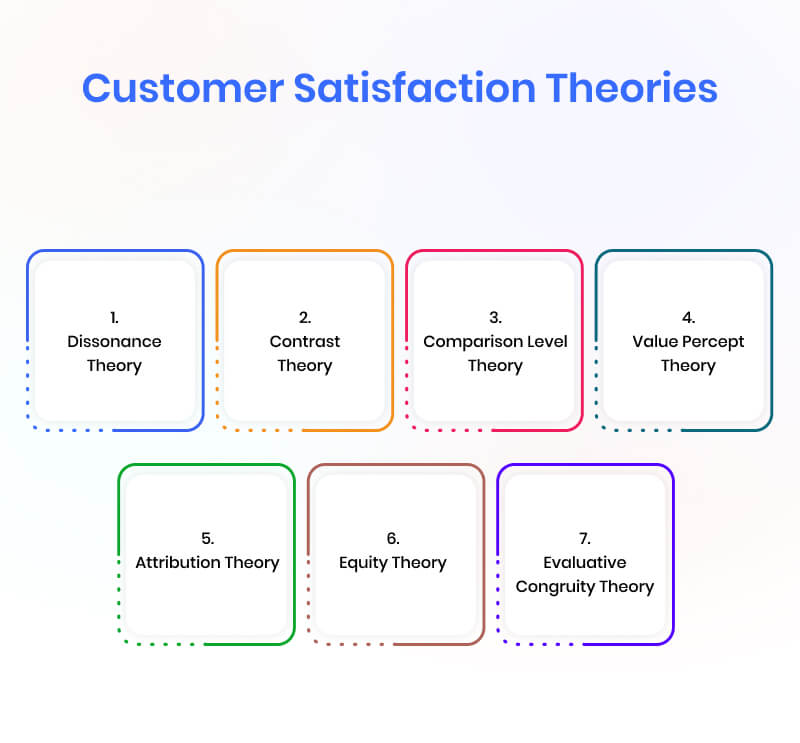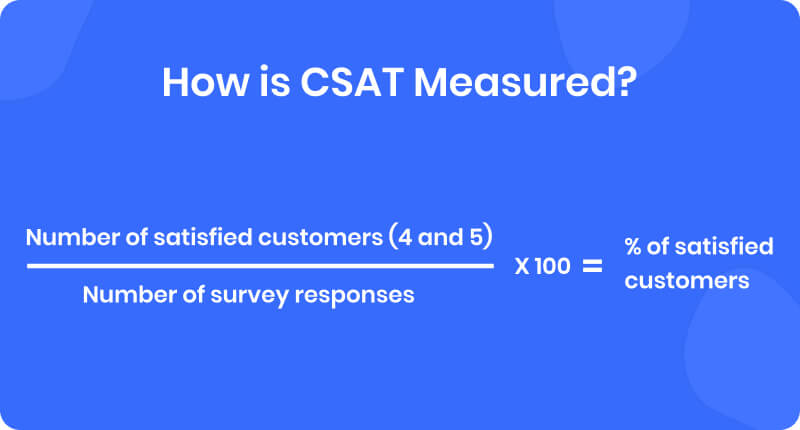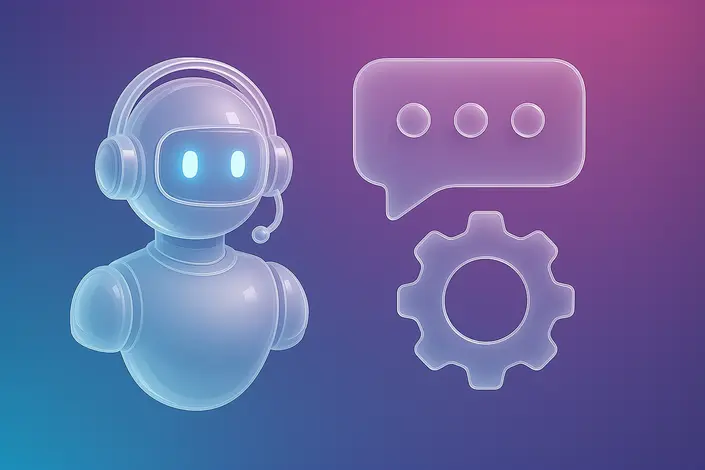7 Most Important Customer Satisfaction Theories
- September 6, 2022
- 11 mins read
- Listen

Every business needs to understand what its customers want and need. The one thing that a customer would never compromise while making any purchase is their satisfaction. A customer is more likely to make a repeat purchase from a business if they are treated well and given the best possible options to choose from.
51% of customers will never do business with that company again just after one poor Customer Experience. — Newvoicemedia.
This article will guide you to understand the various types of customer satisfaction theory. Let’s find some of the important theories about customer satisfaction.
What is Customer Satisfaction Theory?
Customer satisfaction is a general principle of customer service. It measures a customer’s perception of the quality and utility of a product or service. Customer satisfaction can be measured by offering a service, or product or by having a relationship with a company, brand, or individual.
Customer satisfaction theory was introduced by Fred Reichheld in his book The Ultimate Question: Driving Good Profits and True Growth which was published in 2003. It was based on a study of over 25,000 customers from 1998 – 2003.
Customer satisfaction is the cornerstone of any business, not just those in the service industry. Understanding your customers and creating a system to create a satisfying experience for them will enable you to boost your profits and customer retention.
To achieve customer satisfaction, you must understand your customers’ needs and wants and their pain points. Only then can you make sure they are fulfilled with each interaction.
Customer Satisfaction Theories
Understanding the customer satisfaction theory is crucial and may help you save your business if you are in the middle of a crisis resulting from a decline in customer satisfaction.
It lays down important steps you can use to solve the problem that will bring back your customer base and prevent you from losing your business to competitors who have higher customer satisfaction than you do.

- Dissonance Theory
- Contrast Theory
- Comparison Level Theory
- Value Percept Theory
- Attribution Theory
- Equity Theory
- Evaluative Congruity Theory
Let’s take a look at various types of customer satisfaction theories.
1. Dissonance Theory
Dissonance Theory (also known as dissonance reduction theory) is a term used in psychology that refers to the mental stress experienced by someone who simultaneously holds two or more contradictory beliefs, ideas, or values. In other words, they find themselves in conflict.
It also suggests that a person who expected a high-value product and received a low-value product would recognize the disparity and experience cognitive dissonance. That is, the disconfirmed expectations create a state of dissonance or psychological discomfort.
Dissonance Theory can explain our present experience of cognitive dissonance when a customer experiences the physical manifestation of a company’s brand promise but does not receive the level of customer service he or she expected.
For example, you purchase an expensive pair of headphones from a well-known brand. You take them home and find that the headphones are defective.
When you contact the customer service department about this problem, your call is routed to a voice mailbox where you’re told to leave a message and will be contacted within 24 hours. You never receive a call back so you call again several times over the next several days.
2. Contrast Theory
It is another well-known theory of customer satisfaction. Contrast Theory suggests the opposite of the Dissonance Theory. According to this theory, when actual product performance falls short of the consumer’s expectations about the product, the contrast between the expectation and outcome will cause the consumer to exaggerate the disparity.
This implies that the negative impact of actual product performance on customer satisfaction is greater than the positive impact of higher performance on lower performance.
Contrast Theory states that, when the expectation of a product is high and the actual product performance is perceived to be low, the consumer will exaggerate the difference between the expectation and the outcome.
Contrast theory proposes that we do not judge qualities on the basis of absolute standards, but rather on the basis of how they compare with other qualities.
3. Comparison Level Theory
According to the HLT, satisfaction is not the evaluation of a product or service after it has been consumed. Instead, it is the comparison level, or the degree to which a product or service is better than any of the other options that are available in the market.
The theory suggests that consumers set a comparison level in their minds with respect to several aspects while they begin evaluating a product or service. These aspects include:
- The price at which the product was purchased
- The expectations pertaining to quality
- The expectations pertaining to performance
- The expectations pertaining to the features and functionalities of the product
- The comparison level set by an individual’s peers, family members, and friends
- The comparison level was set by all other customers who bought the same brand
The extent to which a product meets or exceeds the comparison level (CL) is the basis of customer satisfaction.
The comparison-level theory is a branch of marketing theory that states that consumers evaluate their level of satisfaction based on an implicit comparison to an internal standard, rather than the outcome they actually experienced.
Critics of this theory suggest that it is nuanced and that it is incomplete. One of the main criticisms made of CLT is that it does not take into account other important determinants of customer satisfaction, such as relevance and quality (Yi, 1990).
4. Value Percept Theory
Value perception is a popular theory on customer satisfaction. This can be seen clearly in many of the recurrent types of cases, such as cases involving brand switching, cases involving the failure of trial products, and cases involving the purchase of services.
A common characteristic in such cases is that consumers base their evaluations on products, services, and brands that are absent from their initial perceptions. Value-Percept Disparity theory has also been applied to explain why consumers value some brands, products, and services over others, even if these other brands, products, and services are more highly expected (e.g., Westbrook 1992).
The Value-Percept theory explains customer satisfaction by two factors that are central to customer perception of value – Actual Value (AV) and Ideal Value (IV). AV is the actual quality or performance of a product that is perceived by a customer.
IV is the “ideal” quality or performance of a product that a customer expects before purchasing the product. The difference between AV and IV can be named Perceptual Discrepancy (PD).
5. Attribution Theory
The Attribution theory has been mostly used in dissatisfaction/ complaining behavior models than in satisfaction models.
According to this theory of the customer satisfaction model, consumers are regarded as rational processors of the information who seek out reasons to explain why a purchase outcome, for example, dissatisfaction, has occurred. These reasons may include the product itself, the service, the price, and even the person who sold the product.
Frequently these reasons are highly correlated to each other, a state of affairs we refer to as inter-correlated attributions. In that case, we can use a simpler model that attributes the “blame” to one of these reasons. The most frequently occurring reason is then called the primary cause.
The attribution theory was developed in the domain of social psychology by Fritz Heider, Dorwin Cartwright, and Leonard Bostwick in a publication entitled “The Psychology of Judgment”. In this publication, the authors pointed out that people are rational in their judgment processes and that there are conditions under which their judgment is rational.
These researchers argued that there are three criteria for attribution to be made: consistency, consensus, and coherence or correspondence.
The consistency criterion includes the notion that when an outcome occurs, people need to find reasons to account for it.
6. Equity Theory
Equity theory in customer satisfaction is the idea that individuals require consistency between what was expected and what was experienced. Consistency between both sides of this equation is key to providing customers with a positive language customer experience.
Learning how to manage expectations and consistently deliver an experience that meets and exceeds them builds goodwill and trust, which leads to strong customer satisfaction.
From my understanding, equity theory in customer satisfaction applies to any kind of purchase. The buyer has a sense of how the product or service is going to turn out, and what to expect from the business or brand.
When that buying decision takes place, the seller needs to make sure that the experience is consistent with the seller’s promise of what is to be received. If not, then the buyer has been provided with an uneven or inequitable exchange of money for goods or services. This causes dissatisfaction.
When I think of equity theory applied to customer satisfaction, I think of it from a transactional point of view. For business, maintaining and improving customer equity is equally important as it has a direct impact on profit and revenue.
7. Evaluative Congruity Theory
Evaluative congruity theory (sometimes abbreviated as EC theory) is a dual-process model of attitude formation and change. The goal of EC theory is to explain the formation and change of attitudes, although it has a broader application as well.
The EC theory posits that attitudes are formed from two different types of evaluations: “incorporating” evaluations and “social comparison” evaluations. It assumes that incorporating evaluations are automatically processed whereas social comparison evaluations require additional effort to process.
Evaluative Congruity describes the extent to which a consumer’s emotions with respect to the evaluative beliefs and attitudes he or she holds about the consumption experience.
It can be applied to all types of services such as hospitality, retail, leisure, and healthcare. Evaluative congruity has also been extended to other areas such as organizational behavior, marketing, and management.
How is CSAT Measured?
There is a customer satisfaction rating scale that helps you measure whether customers are happy with your brand. You can calculate the percentage of satisfied customers by dividing the number of satisfied customers (4 or 5) by the total number of survey responses. This will give you a percentage. Then multiply it by 100 to convert the figure into a whole number.

(Number of satisfied customers (4 and 5) / Number of survey responses) x 100 = % of satisfied customers
How Does CSAT Differ From Net Promoter Score (NPS)?
Now let’s find out how the customer satisfaction theory differs from NPS. Net Promoter Score (NPS) is a simple, easy-to-interpret metric that can be calculated from a single question: How likely is it that you would recommend our company/product/service to a friend or colleague?
CSAT (Customer Satisfaction) measures customer satisfaction with a product or service, whereas NPS (Net Promoter Score) measures customer loyalty to the organization. CSAT is just one way of measuring how satisfied your customers are with your product. This can be done at any one time and depends on how the satisfaction process was answered.
NPS on the other hand is the measure of how likely your customers are to recommend your business to friends and family. This is a measure of future behavior, hence its predictive value is much higher than that of CSAT.
From Theory to Practice: Start Measuring Satisfaction?
Your customers are getting smarter, and they are expecting more. They want a personalized experience and they want it now.
In an ever-changing retail environment, you need to be able to adapt and innovate quickly in order to stay ahead of your competitors. However, in order to do this successfully, you need to know who your customers are, what they want, and how you can improve your products and services to meet their needs.
With the REVE AI Chatbot, you can measure these components and more, and gather the insights you need to make decisions about your customer experience strategy.
With our AI Chatbot, you can measure feature perception, satisfaction, and recommendations for all of your products/services.
What does this mean? It means that our AI Chatbot allows you to understand what the customer actually thinks about the product. This is different than simply asking the customer.
No credit card is required. Sign up now and enjoy 14 days free trial.
Frequently Asked Questions
Customer satisfaction theory explores the factors influencing a customer’s perception of the products, services, and overall experience with a brand. It includes several models that aim to explain how customer expectations, perceptions, and experiences shape their satisfaction levels. The theory emphasizes the importance of delivering quality service, meeting customer expectations, and resolving issues promptly to enhance satisfaction and loyalty.
Oliver’s Customer Satisfaction Theory, known as the Expectancy-Disconfirmation Model, posits that customer satisfaction is the result of the comparison between expectations before a purchase and the actual performance post-purchase. If the performance exceeds expectations, satisfaction increases; if it falls short, dissatisfaction occurs. This model helps businesses understand how to meet or surpass customer expectations to enhance satisfaction.
Philip Kotler’s theory on customer satisfaction emphasizes that customer satisfaction is a direct result of perceived product or service quality and the value delivered to customers. Kotler suggests that businesses should focus on consistently meeting customer needs through superior value, product performance, and customer service to build long-term satisfaction and loyalty.
Thomassen’s theory of customer satisfaction focuses on the multi-dimensional aspects of satisfaction, considering both cognitive and emotional factors. His model suggests that satisfaction comes from both functional (performance-related) and emotional (affective experience) factors that collectively contribute to a customer’s overall evaluation of a product or service.
Atkinson’s theory of customer satisfaction revolves around the concept of goal achievement. It suggests that customer satisfaction is influenced by the degree to which a product or service helps customers achieve their goals. Higher satisfaction occurs when customers feel that their needs have been fully met through the product or service’s functionality and effectiveness.
Customer satisfaction theory is crucial for businesses because it helps them understand what drives customer loyalty, repeat purchases, and positive word-of-mouth. Satisfied customers are more likely to return and recommend the business to others, directly impacting profitability and long-term growth. By applying customer satisfaction theories, businesses can improve product offerings, enhance service quality, and meet customer expectations effectively.
Some notable customer satisfaction theories include:
- Expectancy-Disconfirmation Theory (Oliver): Customers compare expectations and actual performance.
- Equity Theory: Focuses on fairness in transactions and the customer’s perception of value received versus what was paid.
- Cognitive Dissonance Theory: Suggests that customers experience dissatisfaction when there is a mismatch between their beliefs and the product or service experience.
- SERVQUAL Model: Measures service quality based on tangibles, reliability, responsiveness, assurance, and empathy.
Customer feedback is essential in customer satisfaction theory as it provides valuable insights into customer perceptions, expectations, and experiences. By gathering feedback through surveys, reviews, and direct interactions, businesses can identify areas for improvement, measure satisfaction levels, and make informed decisions to enhance products and services, ensuring that customer expectations are met or exceeded.



